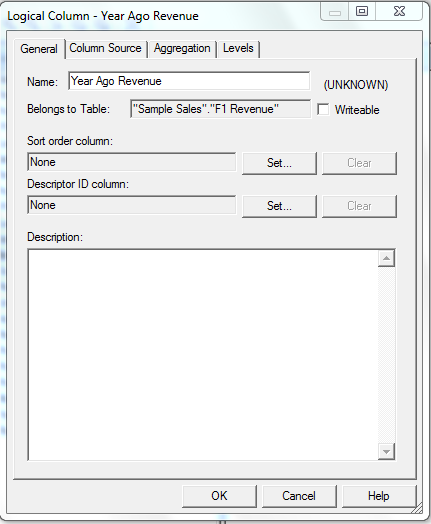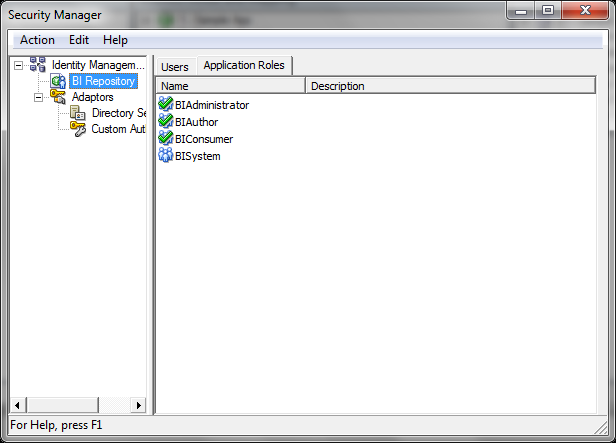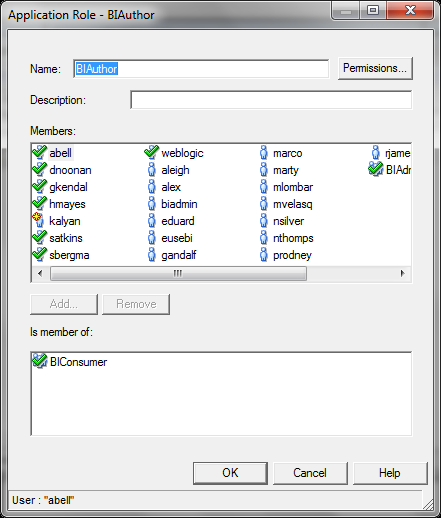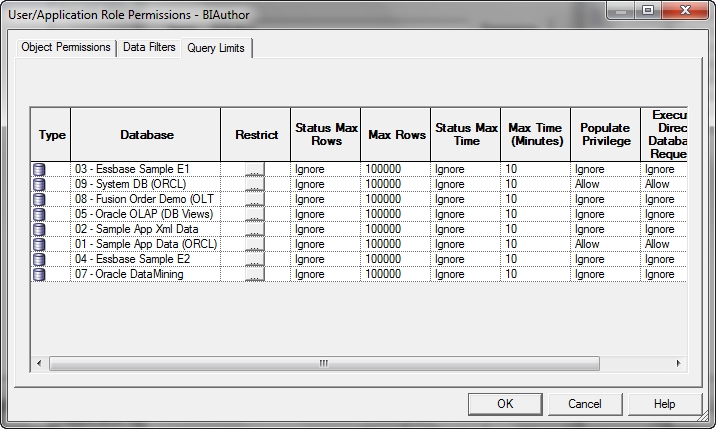Oracle 1z0-591 Exam Practice Questions (P. 2)
- Full Access (120 questions)
- Six months of Premium Access
- Access to one million comments
- Seamless ChatGPT Integration
- Ability to download PDF files
- Anki Flashcard files for revision
- No Captcha & No AdSense
- Advanced Exam Configuration
Question #6
What are the two methodologies that are followed within an OBIEE implementation?
- ADo not use prototypes
- BUse an iterative approach
- CStart with a small model and then enhance the repository
- DStart with a big repository and trim it down with the requirements
Correct Answer:
BC
BC
send
light_mode
delete
Question #7
Which option describes how OBIEE Integrates with Planning?
- AOBIEE primarily accesses Planning using standard Essbase integration techniques.
- BOBIEE provides complete access to all Planning data through the Analytic Data Model (ADM) layer.
- CPlanning is not a supported OBIEE source.
- DOBIEE integrates with Planning directly through relational database access.
Correct Answer:
AB
A:
* Combining Relational and OLAP Data Sources: Oracles Common Enterprise Information Model allows users to combine data from a relational system and an
OLAP source in a single calculation. For example, a user can compare sales forecasts from an Oracle CRM System with budget data from an Oracle Essbase planning application. To clients of the Common Enterprise Information Model, the forecast and budget data appear to be from the same logical source.
* The Essbase server provides advanced multi-user read and write capabilities, including data update and multi-user recalculation. Business users with front-end tools can write data back to a server and recalculate the data on a server using calculation scriptskey functionality to support sophisticated modeling and planning applications.
* Using aggregate storage, Essbase serves a wide range of analytic needsfinancial analysis, planning, budgeting, sales analysis, marketing analysis, supply- chain analysis, and profitability analyticsall from a single analytic infrastructure.
B:
Note: The Analytic Data Model (ADM) is an API used to access OLAP data and metadata. ADM is similar to JDBC, providing a single common API that hides most differences between OLAP data sources.
Note 2: Data model for business intelligence
The most important component of business intelligence is the concept of 'data model'. data model determinde what kind of analysis that end user could do with the data. It is also an independant concept that could span across different vendor 's product.
Unlike data model of the transaction system, the typical analytic data model is often denormalized and store extra data for analytic query and better query performance while transaction data model use is often normalized and optimized for a few data read and write, which is implemented by jointing many tables.
The most common used analytic data model in business intelligence is call the 'Star schema' data model.
With the Oracle business intelligence system, We could define star schema and dimension data model in the 'logical layer' in the admin tools. The data model in
OBIEE could span different data source in physical layer, which means OBIEE have the capability of building one logical data model which is actually connect to different database in the backend
AB
A:
* Combining Relational and OLAP Data Sources: Oracles Common Enterprise Information Model allows users to combine data from a relational system and an
OLAP source in a single calculation. For example, a user can compare sales forecasts from an Oracle CRM System with budget data from an Oracle Essbase planning application. To clients of the Common Enterprise Information Model, the forecast and budget data appear to be from the same logical source.
* The Essbase server provides advanced multi-user read and write capabilities, including data update and multi-user recalculation. Business users with front-end tools can write data back to a server and recalculate the data on a server using calculation scriptskey functionality to support sophisticated modeling and planning applications.
* Using aggregate storage, Essbase serves a wide range of analytic needsfinancial analysis, planning, budgeting, sales analysis, marketing analysis, supply- chain analysis, and profitability analyticsall from a single analytic infrastructure.
B:
Note: The Analytic Data Model (ADM) is an API used to access OLAP data and metadata. ADM is similar to JDBC, providing a single common API that hides most differences between OLAP data sources.
Note 2: Data model for business intelligence
The most important component of business intelligence is the concept of 'data model'. data model determinde what kind of analysis that end user could do with the data. It is also an independant concept that could span across different vendor 's product.
Unlike data model of the transaction system, the typical analytic data model is often denormalized and store extra data for analytic query and better query performance while transaction data model use is often normalized and optimized for a few data read and write, which is implemented by jointing many tables.
The most common used analytic data model in business intelligence is call the 'Star schema' data model.
With the Oracle business intelligence system, We could define star schema and dimension data model in the 'logical layer' in the admin tools. The data model in
OBIEE could span different data source in physical layer, which means OBIEE have the capability of building one logical data model which is actually connect to different database in the backend
send
light_mode
delete
Question #8
What is an example of a Session Variable?
- AETL Load Date
- BUser Organization
- COLAP DSN
- DTop Customers by Revenue
Correct Answer:
B
Note 1: There are four types of variables that you can use:
Session -
Repository -
Presentation -
Request -
Note 2: Session Variables -
A session variable is a variable that is initialized at login time for each user. When a user begins a session, the Oracle BI Server creates a new instance of a session variable and initializes it.
There are as many instances of a session variable as there are active sessions on the Oracle BI Server. Each instance of a session variable could be initialized to a different value.
There are two types of session variables:
System A session variable that the Oracle BI Server and Oracle BI Presentation Services use for specific purposes.
System session variables have reserved names that cannot be used for other kinds of variables (such as static or dynamic repository variables and non-system session variables).
Non-system A system variable that the administrator creates and names. For example, the administrator might create a SalesRegion non-system variable that initializes the name of a user's sales region.
The administrator creates non-system session variables using the Oracle BI Administration Tool.
Incorrect answers:
A: ETL Load Date is a DAC Source System Parameter.
C: OLAP DSN is a Repository variable.
B
Note 1: There are four types of variables that you can use:
Session -
Repository -
Presentation -
Request -
Note 2: Session Variables -
A session variable is a variable that is initialized at login time for each user. When a user begins a session, the Oracle BI Server creates a new instance of a session variable and initializes it.
There are as many instances of a session variable as there are active sessions on the Oracle BI Server. Each instance of a session variable could be initialized to a different value.
There are two types of session variables:
System A session variable that the Oracle BI Server and Oracle BI Presentation Services use for specific purposes.
System session variables have reserved names that cannot be used for other kinds of variables (such as static or dynamic repository variables and non-system session variables).
Non-system A system variable that the administrator creates and names. For example, the administrator might create a SalesRegion non-system variable that initializes the name of a user's sales region.
The administrator creates non-system session variables using the Oracle BI Administration Tool.
Incorrect answers:
A: ETL Load Date is a DAC Source System Parameter.
C: OLAP DSN is a Repository variable.
send
light_mode
delete
Question #9
Which option is used to enter the rank function when creating a new rank measure?
- AInitialization Block
- BExpression Builder
- CConnection Pool
- DWeb Catalog
Correct Answer:
B
Example (see step 4 and 5 below): Getting Top-N Sales Reps for Year and Year-1
1. Under the "Business Model and Mapping" Layer, right click the "F1 Revenue" and select "New Object" -> "Logical Column…"
2. In the "Logical Column" Window give for Name: Year Ago Revenue as seen below:

3. Goto the "Column Source" Tab and select "Derived from existing columns using an expression" radio button then click on the "Edit Expression" icon.
4. Enter the following expression in the "Expression Builder" Window by selecting "Functions" in the "Category:" list, "Time Series Functions" in the "Functions:" list then "Ago" "Time Series Functions:" section.
5. Select the "<<Measure>>" in the "Ago( )" function, then select "Logical Tables" in the "Category:" list, "F1 Revenue" in the "Logical Tables:" list, then double click the "Revenue" in the "Columns:" list.
Etc.
B
Example (see step 4 and 5 below): Getting Top-N Sales Reps for Year and Year-1
1. Under the "Business Model and Mapping" Layer, right click the "F1 Revenue" and select "New Object" -> "Logical Column…"
2. In the "Logical Column" Window give for Name: Year Ago Revenue as seen below:

3. Goto the "Column Source" Tab and select "Derived from existing columns using an expression" radio button then click on the "Edit Expression" icon.
4. Enter the following expression in the "Expression Builder" Window by selecting "Functions" in the "Category:" list, "Time Series Functions" in the "Functions:" list then "Ago" "Time Series Functions:" section.
5. Select the "<<Measure>>" in the "Ago( )" function, then select "Logical Tables" in the "Category:" list, "F1 Revenue" in the "Logical Tables:" list, then double click the "Revenue" in the "Columns:" list.
Etc.
send
light_mode
delete
Question #10
Query limits tab can be accessed through________.
- ASecurity Manager, Query tab, Application role dialog box, Permissions
- BSecurity Manager, Application Roles tab, Query dialog box, Permissions
- CSecurity Manager, Application Roles tab, Application role dialog box, Permissions
- DSecurity Manager, Application Roles tab, Application role dialog box, Query Properties
Correct Answer:
C
Query environment can be managed by setting query limits (governors) in the Repository (RPD) for particular Application Roles. You should always set query limits for particular application roles rather than for individual users.
Steps:
1. Login to Repository using OBIEE Admin Tool
2. Navigate to Manage > Identity
3. Go to Application Role tab, choose the role and double click on it to open.

4. Click on Permissions tab

5. Set the Query Limits. You can limit queries by the number of rows received, by maximum run time, and by restricting to particular time periods. You can also allow or disallow direct database requests or the Populate privilege.

C
Query environment can be managed by setting query limits (governors) in the Repository (RPD) for particular Application Roles. You should always set query limits for particular application roles rather than for individual users.
Steps:
1. Login to Repository using OBIEE Admin Tool
2. Navigate to Manage > Identity
3. Go to Application Role tab, choose the role and double click on it to open.

4. Click on Permissions tab

5. Set the Query Limits. You can limit queries by the number of rows received, by maximum run time, and by restricting to particular time periods. You can also allow or disallow direct database requests or the Populate privilege.

send
light_mode
delete
All Pages
